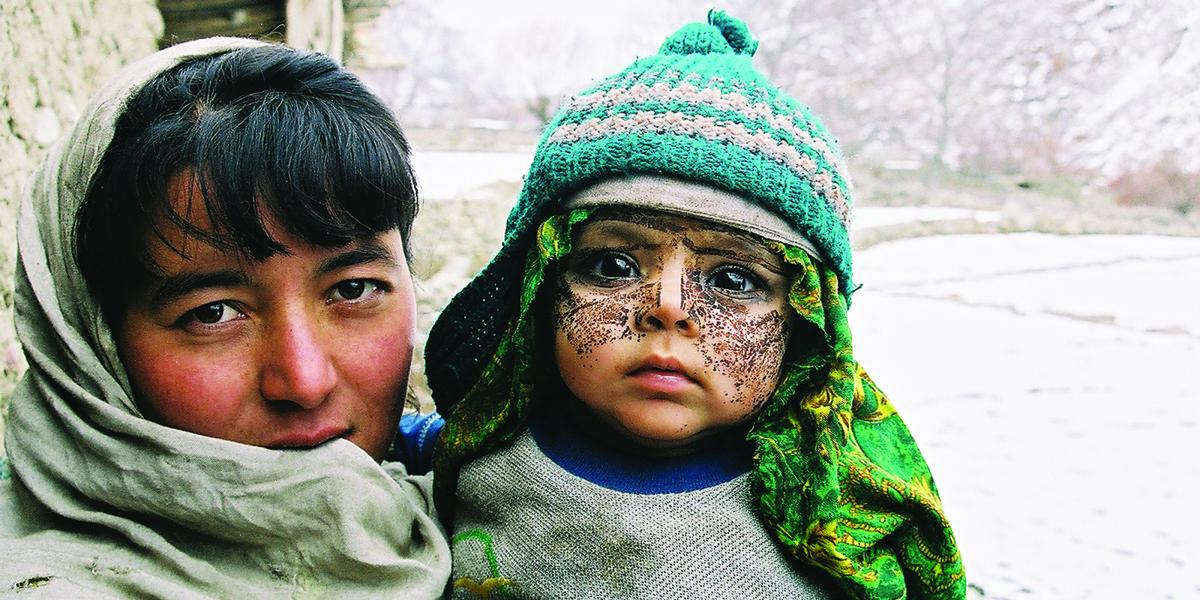A Jewel for Disease Tracking
A button-sized tag on an infant’s bracelet is improving accuracy and speeding results in a pneumonia study in Pakistan.
In Pakistan, the centuries-old tradition of encircling a baby’s ankle or wrist with a beaded bracelet is meant to protect the child, to ward off the “evil eye.”
But the custom has gone high-tech in a Bloomberg School study designed to document the need for a pneumococcal vaccine in Pakistan, where pneumonia is the second leading cause of death in children under five.
Threaded among the black beads of the study-issued bracelets that adorn more than 4,500 babies in a low-income Karachi neighborhood is a button-size radio frequency identification (RFID) tag. The device can use radio waves to transmit real-time surveillance data via cell phones to a central computer server. The jewelry is at the heart of an innovative, disease-tracking system that Bloomberg School researchers hope will yield persuasive data on childhood pneumonia incidence to share with Pakistan’s government.
“We hope our data will show the government that there is enough pneumococcal disease to warrant the introduction of a pneumococcal vaccine,” says Hamidah Hussain, MD, MSc, associate in International Health and director of the Karachi Invasive Pneumococcal Disease Surveillance Project. The study is supported by the Program for Appropriate Technologies in Health.
According to UNICEF, pneumonia accounts for 13 percent of deaths in children under five in Pakistan.
Pakistan’s government added a new vaccine in December 2008 against Hib (Haemophilus influenzae type b)—a leading cause of bacterial meningitis in children and a cause of childhood pneumonia—with support from the Global Alliance for Vaccine and Immunisation (GAVI). But a separate vaccine is needed to protect children against pneumococcal disease, also a significant contributor to childhood illness.
“We believe that much of the pneumonia [in developing countries] is preventable with the newer vaccines that have been developed,” says Neal Halsey, MD, a professor in International Health and the study’s principal investigator. “But first we have to measure the burden of disease.”
The study’s electronic disease-tracking system—Interactive Alerts—is designed to collect such data quickly and efficiently and, ultimately, researchers say, hasten the progression of vaccine trials, particularly in developing countries.
The project, which began in November 2008, is scheduled to conclude by mid-2010. Enrollment takes place at government-run Expanded Immunization Centers (EPI), where mothers bring their six-week-old infants for their first round of vaccinations. If a mother agrees to take part in the project, a field worker assigns an RFID-tagged bracelet/anklet to the baby, which will remain with the child as researchers collect data until the child is 18 months old.
Family doctors at 40 clinics participating in the study have study-issued cell phones with Interactive Alerts software. When a mother enrolled in the project brings a sick child to the clinic, the physician uses the cell phone to activate the RFID tag, which brings up the child’s identification information on the phone screen and alerts study staff that the child is at the clinic. The physician examines the child and chooses one of four numbered options on the phone screen—pneumonia/severe pneumonia, meningitis, dehydration or other. The doctor then selects “send” to relay the data to the central server, allowing researchers to monitor the information as it comes in on the study website.
“A person sitting in Pakistan, me in Vancouver and Neal [Halsey] in Baltimore, can all look up on the website and see immediately that today10 children enrolled in the study, there are five reported illnesses, they went to X or Y physician, and what happened,” says Hussain.
According to the most recent data, there have been 89 reported cases of pneumonia or severe pneumonia, and two cases of sepsis/meningitis. All children were treated successfully at partner hospitals.
“This technology is incredibly powerful for those of us who do these studies; it’s really changing the way we work,” says the study’s Karachi-based principal investigator, Aamir Khan, MD, PhD ’06, an associate in International Health and executive director and founder of Interactive Research & Development (IRD), a nonprofit focused on advancing public health in developing countries through the use of low-cost technology.
The system has virtually eliminated paper from the disease-tracking process in this study, allowing for greater accuracy of data and making it possible for researchers to address problems and identify data trends, Hussain says.
“A physician may not be sending you any cases of pneumonia and that leads us to question [whether it is] right that he is not seeing any or is there some gap in training and he’s not really sending what he should be sending,” she says. “We can identify issues like that and work with that one doctor.”
The Interactive Alerts system grew in part out of Khan’s doctoral work on a childhood pneumonia surveillance project 10 years ago in the Himalayas of north Pakistan. He became frustrated with the error-prone, unwieldy techniques of traditional disease surveillance. The experience led to IRD’s collaboration with a consortium of academic institutions to design a more efficient tracking system.
“We figured if we get the public health folks in the same room with engineers, we can find unique and novel solutions to problems,” Khan says.
The Interactive Alerts system now in use is the result of four years of work developing and fine-tuning the electronic data-collection technology. Key to the success of the project, however, is the low-tech ankle bracelet as a culturally acceptable, portable data-storage method. It was selected by study leaders after months of focus groups.
Looking ahead, says Khan, the technology has the potential to significantly shorten the time it takes to move from fieldwork to public health policy. “If you have good quality data coming from the field,” Khan says, “it shortens by months, if not by a year or more, the time that it takes to complete a vaccine trial.”
